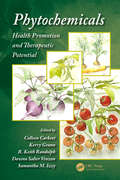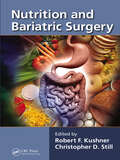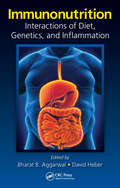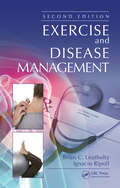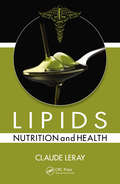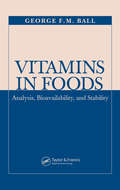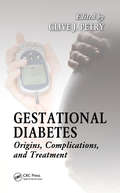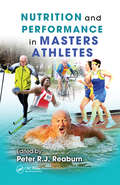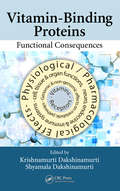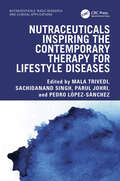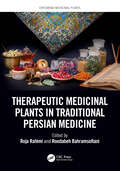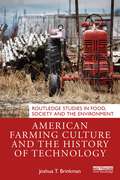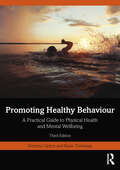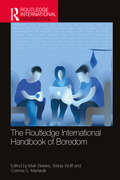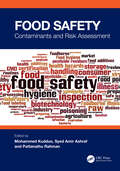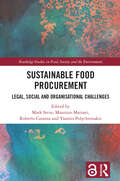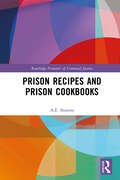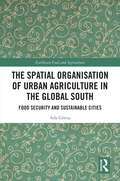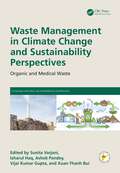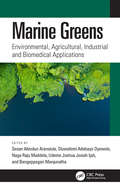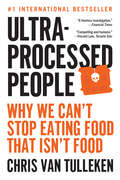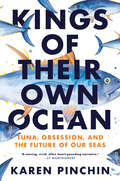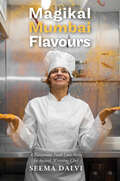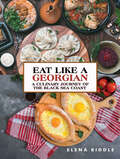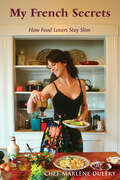- Table View
- List View
Phytochemicals: Health Promotion and Therapeutic Potential
by Colleen Carkeet Kerry Grann R. Keith Randolph Dawna Salter Venzon Samantha M. IzzyIncreasing knowledge of the various protective effects of phytochemicals has sparked interest in further understanding their role in human health. Phytochemicals: Health Promotion and Therapeutic Potential is the seventh in a series representing the emerging science with respect to plant-based chemicals. Drawn from the proceedings at the Seventh In
Nutrition and Bariatric Surgery
by Robert F. Kushner Christopher D. StillBariatric surgery has led to improved health outcomes including significant weight loss and reduction in co-morbidities among patients with obesity. Clinical practice guidelines recommend that patients considering bariatric surgery undergo a comprehensive nutritional assessment. Nutrition and Bariatric Surgery is the first comprehensive book that u
Immunonutrition: Interactions of Diet, Genetics, and Inflammation
by Bharat B. Aggarwal David HeberThe interaction of immune function and nutrition underlies the low-grade chronic inflammation involved in the etiology of many common obesity-associated and age-related chronic disease conditions. This close interaction is the genesis of the term immunonutrition, which represents a new interdisciplinary field of nutritional and medical research. Im
Exercise and Disease Management
by Brian C. Leutholtz Ignacio RipollExercise and Disease Management is designed to help managed care physicians, their patients, other health care professionals, and interested readers integrate current exercise guidelines into their practices. This extraordinary book is accompanied by a series of 11 workbooks, each one for a chronic disease, designed specifically for physicians to give to their patients. These workbooks make it convenient for physicians to prescribe physical activity to their patients in a ready-to-use format. Each book chapter and workbook contains a section on the background, medical management, and exercise guidelines, accompanied by self-care instructions for patients, encouraging them to take a proactive role in their health and disease management. New and Updated in the Second Edition: A ready-to-use "Exercise Prescription Page," which follows each chapter on a specific disease, enables health care professionals, especially physicians in managed care, to prescribe exercise quickly to clients with specific medical conditions The "Rate Pressure Product" method for prescribing exercise helps health care providers individualize exercise prescriptions for patients with heart disease by accounting for the amount of oxygen the heart uses Individual companion workbooks on the downloadable resources provide patient health maintenance information about diabetes, AIDS, obesity, golden years (age 65 and older), heart, kidney, peripheral arterial, and lung disease. Workbooks for physical inactivity, osteoporosis, arthritis and high blood pressure also are included on the downloadable resources Common question-and-answer sections that help patients understand the diseases from which they suffer and encourages them to take responsibility for their health Exercise and Disease Management, Second Edition consolidates the current knowledge base on exercise and chronic disease, providing a ready-made format for health care providers to use when prescribing exercise programs for their clients. Using guidelines set forth by the American College of Sports Medicine and the American Association of Cardiovascular and Pulmonary Rehabilitation, this book helps physicians, other health care providers, and health enthusiasts respond to the challenge to keep patients healthier and active and reduce recurrent hospitalizations and health care costs.
Lipids: Nutrition and Health
by Claude LerayThe role of lipids in nutrition science has evolved considerably in the past decade with new concepts following new discoveries. Lipids: Nutrition and Health reviews the role of dietary lipids in maintaining health, bringing the latest knowledge from a myriad of sources into one convenient resource. Taking a combined approach that integrates lipid
Vitamins In Foods: Analysis, Bioavailability, and Stability (ISSN)
by George F.M. BallTo achieve and maintain optimal health, it is essential that the vitamins in foods are present in sufficient quantity and are in a form that the body can assimilate. Vitamins inFoods: Analysis, Bioavailability, and Stability presents the latest information about vitamins and their analysis, bioavailability, and stability in foods.
Gestational Diabetes: Origins, Complications, and Treatment
by Clive J. PetryGiven the rapid increase in the worldwide incidence of gestational diabetes, the need for defining the risks and effects associated with raised glucose concentrations in pregnancy is great. Recent large studies are helping to define the risks, as well as identify the benefits of reducing glucose intolerance. Written by an esteemed list of internati
Nutrition and Performance in Masters Athletes
by Peter R.J. ReaburnAddresses the Aging Process and Its Effect on Sports PerformanceAge-related changes influence all physiological systems, including those used during exercise and sport. Highlighting masters athletes-older adults who train and compete in organized sports-Nutrition and Performance in Masters Athletes examines the extent to which regular physical trai
Vitamin-Binding Proteins: Functional Consequences
by Krishnamurti Dakshinamurti Shyamala DakshinamurtiDiverse in chemical nature, water soluble and lipid soluble vitamins are essential micronutrients that react with specific protein entities and are transported to sites for participation in intracellular events, both at the genomic and non-genomic levels. Thus, metabolic pathways and intracellular signaling are influenced by vitamins or their deriv
Nutraceuticals Inspiring the Contemporary Therapy for Lifestyle Diseases (Exploring Medicinal Plants)
by Sachidanand Singh Parul Johri Mala Trivedi Pedro López-SánchezIn today's fast-paced and modern world, our lifestyles have undergone a dramatic shift. The conveniences and comforts that accompany our technological advancements have come at a cost – an increased prevalence of lifestyle diseases. Lack of physical activity, stress, sedentary habits, and poor dietary choices have become leading causes of a spurt in varied health complications such as obesity, diabetes, and cardiovascular diseases. Various health awareness programmes organized by central/state governments, private organizations, and NGOs from time to time have generated interest among common people in exploring organic foods that are free from chemicals and full of nutraceuticals. There has been a growing interest in exploring the potential of nutraceuticals to address lifestyle diseases.Recognizing the urgent need to address this global health crisis, this book delves into a realm of science that offers immense potential for improving our health and well-being. Nutraceuticals, which combine "nutrition" with "pharmaceuticals," offer a promising strategy for treating certain conditions caused by a particular way of life. They include a variety of bioactive substances obtained from plants, including fruits, vegetables, herbs, and marine organisms. Certain substances have therapeutic qualities and have shown significant promise in treating and even preventing certain disorders.Features: The chapters in this book have been meticulously curated to provide readers with a diverse range of perspectives. Provides a comprehensive exploration of nutraceuticals and their potential benefits. Examines the impact of specific nutraceuticals on various lifestyle diseases to discuss their synergistic effects and potential adverse reactions. Each chapter offers valuable insights and practical guidance for healthcare professionals, researchers, and individuals seeking to enhance their overall well-being. A systematic overview of the state-of-the-art in nutraceuticals with recent research results. This book will certainly be a valuable resource for researchers engaged in studies on nutraceuticals to develop a depth of understanding of the latest trends and tools in this field. Additionally, it can serve as a comprehensive textbook for graduate-level courses in food and nutrition, biomedical, and health sciences.
Therapeutic Medicinal Plants in Traditional Persian Medicine (Exploring Medicinal Plants)
by Roja Rahimi Roodabeh BahramsoltaniTraditional Persian Medicine (TPM) is one of the oldest medical doctrines, globally known due to pioneering physicians and scientists. The greatest source of natural medicines in TPM originates from medicinal plants. Therapeutic Medicinal Plants in Traditional Persian Medicine provides a background on the history of TPM, as well as an introduction to 40 of the most popular medicinal plants used in TPM. It is a practical guide for readers interested in medicinal plants used in the prevention, management, and treatment of different diseases.Features: Includes both traditional therapeutic applications and modern evidence/ uses Makes a comparison between preclinical and clinical studies Provides information on major chemical constituents, therapeutic uses, adverse reactions, and safety for each plant species A volume in the “Exploring Medicinal Plants” series, this book is a valuable resource for researchers, students, academicians, and scientists dealing witth medicinal plants, as well as for those interested in the fields of pharmacognosy, naturopathy, phytotherapy, and traditional medicines.
American Farming Culture and the History of Technology (Routledge Studies in Food, Society and the Environment)
by Joshua T. BrinkmanPresenting a history of agriculture in the American Corn Belt, this book argues that modernization occurred not only for economic reasons but also because of how farmers use technology as a part of their identity and culture.Histories of agriculture often fail to give agency to farmers in bringing about change and ignore how people embed technology with social meaning. This book, however, shows how farmers use technology to express their identities in unspoken ways and provides a framework for bridging the current rural-urban divide by presenting a fresh perspective on rural cultural practices. Focusing on German and Jeffersonian farmers in the 18th century and Corn Belt producers in the 1920s, the Cold War, and the recent period of globalization, this book traces how farmers formed their own versions of rural modernity. Rural people use technology to contest urban modernity and debunk yokel stereotypes and women specifically employed technology to resist urban gender conceptions. This book shows how this performance of rural identity through technological use impacts a variety of current policy issues and business interests surrounding contemporary agriculture from the controversy over genetically modified organisms and hog confinement facilities to the growth of wind energy and precision technologies. Inspired by the author's own experience on his family’s farm, this book provides a novel and important approach to understanding how farmers’ culture has changed over time, and why machinery is such a potent part of their identity.This book will be of great interest to students and scholars of agricultural history, technology and policy, rural studies, the history of science and technology, and the history of farming culture in the USA.
Promoting Healthy Behaviour: A Practical Guide to Physical Health and Mental Wellbeing
by Dominic Upton Katie ThirlawayThe new edition of this leading text is an essential guide to promoting healthy behaviour in a multi-cultural society, providing a holistic stance that integrates both physical and mental health and wellbeing. With a comprehensive overview of the interplay between social class, gender, ethnicity and individual health differences, the book also looks at key lifestyle issues such as eating well, smoking, drinking alcohol and safe sex, as well as the mechanisms for behavioural change. Each chapter features engaging case studies, points for discussion and student activities. Updated since the COVID-19 pandemic, the new edition also discusses the effects of lockdowns on healthy behaviours.An accessible and engaging text, the third edition of Promoting Healthy Behaviour will continue to be essential reading for both students and practitioners across nursing, public health and allied health professions.
The Routledge International Handbook of Boredom (Routledge International Handbooks)
by Maik Bieleke Wanja Wolff Corinna S. MartarelliThis comprehensive text is a unique handbook dedicated to research on boredom. The book brings together leading contributors from across three continents and numerous fields to provide an interdisciplinary exploration of boredom, its theoretical underpinnings, its experiential properties, and the applied contexts in which it occurs.Boredom is often viewed as a mental state with little utility, though recent research suggests that it can be a powerful motivator of human behavior that shapes our actions in many ways. The book examines boredom from a range of perspectives and is comprised of three parts. Part I delves into the theoretical approaches to boredom, presenting methods for its measurement, explaining when and why boredom occurs, and scrutinizing the impact it has on our behavior. Part II focuses on the psychological and neural properties of boredom and its associations with a multitude of mental and interpersonal processes, such as self-control, mind-wandering, flow, and aggression. Part III presents boredom in practical contexts like school and work, and sheds light on its role for health-related behaviors, psychosocial well-being, and aesthetic experiences. The book concludes by summarizing the state of boredom research, identifying promising areas for future research, and providing directions for how research on boredom can be advanced. As the authoritative book on boredom, this handbook is an essential resource for students and researchers of psychology, sociology, education, sport science, and computer science.
Food Safety: Contaminants and Risk Assessment
by Mohammed Kuddus Syed Amir Ashraf Pattanathu RahmanFood Safety: Contaminants and Risk Assessment is a state-of-art reference on food safety, which is the biggest challenge in the food supply chains worldwide. Despite advancements in hygiene, food treatment, and food processing, foodborne pathogens or food contaminants still represent a significant threat to human health. This book presents comprehensive information about the major food contaminants across food types. The text provides facts about setting up food safety initiatives and safety rules, foodborne pathogen detection, production and processing compliance issues, and safety education.Key Features Examines a diverse range of contaminants across food types Describes various food allergens and allergies Discusses contamination in drinking water and bottled water Reviews the international regulations for management of food hazards Throws light on the overall impact of food safety of global food supply chains This book is meant for postgraduate students, researchers, and food industry professionals.
Sustainable Food Procurement: Legal, Social and Organisational Challenges (Routledge Studies in Food, Society and the Environment)
by Mark Stein Maurizio Mariani Roberto Caranta Yiannis PolychronakisThe book examines sustainable food procurement policy and practice in the European Union and beyond, exploring the extent to which sustainability objectives have been achieved and evaluating the new developments taking place at both EU and national levels.While there is a growing recognition that public authorities can use public procurement as a policy tool to pursue multiple environmental, health and socio-economic objectives, contracting authorities still face many challenges. This volume investigates the scope for pursuing sustainable objectives in public procurement of food and catering services, examining different regulatory contexts and organisational models to answer the overall question of how to integrate sustainability concerns into the various phases of public food procurement processes. Contributions in the book examine the policy and legal procurement framework and practices for sustainable public catering in three EU Member States: Italy, France and Spain. There is a comparative survey of the Baltic Region, including Denmark, Estonia, Finland, Poland and Russia, and moving beyond the EU, there is examination of the UK and Brazil, as well as a cross country comparison of the UK with Denmark and Sweden. Drawing on the expertise of an interdisciplinary and intersectoral team of contributors allows the book to benefit from the insights of different disciplines, including business sciences, anthropology and law. Tapping into the global discussion on public food procurement as a means to achieve multiple social and environmental goals, this work will stimulate readers looking for new creative ways to create value through public food purchasing.This book will be of great interest to students, researchers, policymakers and public- and private-sector representatives interested in public procurement, food policy and law, sustainable food sourcing and supply chain management.
Prison Recipes and Prison Cookbooks (Routledge Frontiers of Criminal Justice)
by A.E. StearnsPrison Recipes and Prison Cookbooks provides an innovative exploration of U.S.-based prison cookbooks using a narrative criminological approach.The book relies on the voices of prison cookbook authors to argue that cookbook narratives are a form of communication with the free world. Further, the book undertakes thematic analyses of prison cookery and narratives to illuminate the intersections of incarceration with abolition, gender, literacy, and dehumanization. The reader is introduced to the power and symbolism of cell made food, as well as the agency and resourcefulness of those who cook, bake, and write about food behind bars.Prison Recipes and Prison Cookbooks is of interest to instructors of courses covering the sociology of food, criminology, human geography, and anthropology. The book is also appropriate for prison and probation services, health organizations, and anyone engaged in the criminal-legal system, abolition movements, or social reform.
The Spatial Organisation of Urban Agriculture in the Global South: Food Security and Sustainable Cities (Earthscan Food and Agriculture)
by Ada GórnaThis book examines the role and position of urban agriculture in the spatial and functional structure of cities in the Global South.In the face of dynamic urbanisation and negative consequences of climate change, one of the key challenges is not only how to provide food for the ever-growing urban population but also how to achieve urban sustainability and simultaneously reduce the negative impact of cities on the natural environment. These problems are particularly urgent in the metropolises of the Global South that are experiencing the greatest population growth while struggling with increasing social inequalities and the resulting uneven distribution of resources. Examining the role that urban agriculture can play in addressing these challenges, this book draws on three case study cities: Havana, Singapore and Kigali. The case studies, differing in socio-economic, spatial, political and environmental terms, exemplify diverse characteristics of urban agriculture in different geographical conditions. Drawing on fieldwork conducted in each city, the book also provides a unique perspective on the constraints in the development of urban agriculture and the use of its full potential for urban sustainability.This book will appeal to students and scholars, as well as decision makers, interested in the issues of urban sustainability, food security, spatial development and alternative food systems.
Waste Management in Climate Change and Sustainability Perspectives: Organic and Medical Waste (Sustainable Industrial and Environmental Bioprocesses)
by Sunita Varjani Izharul Haq Ashok Pandey Vijai Kumar Gupta Xuan-Thanh BuiThis handbook discusses the relationships and effects of climate change on waste treatment and its sustainable management. The waste management sector is in a unique position to transition from a minor source of global greenhouse gas (GHG) emissions to a major contributor to reducing GHG emissions. This book compiles the potential impacts and benefits of various waste management systems in terms of climate impact. It investigates the global climate impact of municipal solid waste, commercial and industrial waste, agricultural waste, and hazardous waste management systems.Key features: Reviews advanced and innovative processes for sustainable waste management Covers green waste treatment technologies using microbes, green soldier flies, earthworms and bacteriophages Discusses the negative and positive effects of waste treatment and disposal Provides relevant case studies from different regions of the world Examines the role of climate change on emerging pollutants The book is meant for researchers and professionals in environmental sciences, chemical and biochemical engineering.
Marine Greens: Environmental, Agricultural, Industrial and Biomedical Applications
by Sesan Abiodun Aransiola, Oluwafemi Adebayo Oyewole, Naga Raju Maddela, Udeme Joshua Josiah Ijah, and Bangeppagari ManjunathaThis book provides an in-depth overview of marine greens and their environmental and biotechnological applications. It addresses concepts such as the niche adaptation strategies of marine greens in their natural habitats, as well as their global distribution, and factors affecting their distribution and proliferation.Marine greens are posited as an alternative to fossil fuels, mitigating global climate change and thereby fostering future environmental sustainability. In addition, the book explains the remediation of xenobiotics, wastewater, microplastics, marine debris and marine green contamination. Expert authors from around the world explore the industrial and agricultural applications of marine greens in the production of enzymes and marine bioenergy, and what is needed to improve its production potential.This is important reading for government and non-governmental organizations as well as industries and research institutions looking for ways to combat current industrial and environmental challenges.
Ultra-Processed People: Why We Can't Stop Eating Food That Isn't Food
by Chris van TullekenTHE #1 INTERNATIONAL BESTSELLER • LONGLISTED FOR THE BAILLIE GIFFORD PRIZE FOR NONFICTION • The bestselling and eye-opening investigation into the science, economics, history and impact of ultra-processed food.With a new Afterword by the author.Named a Best Book of the Year by NPR • The Economist • The Times • The New Yorker • Smithsonian • Daily Mail • The Guardian • Financial Times • and more!It's not you, it's the food.How much of our daily caloric intake comes from ingesting substances that, technically speaking, do not meet traditional definitions of &“food&”? Chances are, if you&’re eating something that came wrapped in plastic and contains a funky ingredient you don&’t have in your kitchen, it's most likely—almost definitely—ultra-processed food, or UPF. More than the principal obstacle to &“eating right,&” UPF has been linked to metabolic disease, depression, inflammation, anxiety, and cancer, while the production, distribution, and disposal of UPF and related products globally is known to cause devastating environmental damage. At the same time, UPF represents the dominant, nigh-unavoidable food culture for millions upon millions of eaters.Medical doctor and broadcaster Chris van Tulleken has spent his career trying to reframe the conversation around eating right, balancing the hard (and sometimes shocking) facts about what we're putting into our bodies with empathy for the natural desire to keep eating what we like, have time for, and can afford. As he argues in this book, we are all participants in an experiment we didn't consent to, one to determine how to get us to buy as much ultra-processed food as possible. It&’s not as simple as stumbling across the right diet trend, finding time to meal plan, or avoiding over-indulging in sugar, fat, or carbs or any other culprit. Nor is it a matter of individual will. It&’s about learning to live in &“the third age of eating&”—defined by the overwhelming abundance of ultra-processed eating options—and arming yourself with the simple and not-so-simple facts that will help you make the choices that are right for you.
Kings of Their Own Ocean: Tuna, Obsession, and the Future of Our Seas
by Karen PinchinThe marvelous tale of one fish, the fisherman who first caught her, and how our insatiable appetite for bluefin tuna turned a cottage industry into a massive global dilemma.In 2004, an enigmatic charter captain named Al Anderson caught and tagged one Atlantic bluefin tuna off New England's coast. Fourteen years later that same fish—dubbed Amelia for her ocean-spanning journeys—was caught again, this time in a Mediterranean fish trap. Over his fishing career, Al marked more than sixty thousand fish with plastic tags, an obsession that made him nearly as many enemies as it did friends. His quest landed him in the crossfire of an ongoing fight between a booming bluefin tuna industry and desperate conservation efforts, a conflict that is once again heating up as overfishing and climate change threaten the fish's fate.Kings of Their Own Ocean is an urgent investigation that combines science, business, crime, and environmental justice. Through Karen Pinchin's exclusive interviews and access, interdisciplinary approach, and mesmerizing storytelling, readers join her on boats and docks as she visits tuna hot spots and scientists from Portugal to Japan, New Jersey to Nova Scotia, and glimpse, as Pinchin does, rays of dazzling hope for the future of our oceans.
Magikal Mumbai Flavours: A Passionate Food Love Story
by Chef Seema Dalvi‘Food and culture go hand in hand; as life moves on, we win some and we lose some. There are times where we have to learn to adapt, infusing our life with flavours. So far, my life – including my journey from the classroom to the restaurant – has been blessed with some very old as well as very new recipes of warmth and love. ‘Basic Indian cooking revolves around a healthy lifestyle, and in this wholesome book you will learn to cook old regional dishes like Malvani chicken (from Maharashtra on India’s west coast), Mangshore jhol lamb (from Kolkata on the east coast), Laccha paratha (from the north), Kerala lamb curry (from the south coast), as well as modern fusion dishes from the global food village, such as Mexican chimichangas, Arabic ouzi, Mexican chaat, butter chicken pizza and spiced pesto fried rice – all with an Indian twist. ‘It has been an absolute pleasure and source of pride to share the tips and tricks I have inherited to make Indian cooking an experience for you, whether you are cooking alone or with your family and friends.’ CHEF SEEMA DALVI
Eat Like a Georgian – a Culinary Journey of the Black Sea Coast
by Elena RiddleWhile not everyone has the chance to voyage to far-off lands and indulge in native delicacies, it's often that these world cuisines find their way to us. Whether through a local restaurant, a takeaway order, or a homemade culinary adventure, we’ve become familiar with the flavours of Italy, China, or India. But what about venturing into the unexplored? How about diving into the culinary treasures of a small country, once the eastern frontier of the Roman Empire, boasting a wine-making legacy spanning millennia? Welcome to the rich cuisine of Georgia! Explore its unique recipes, crafted with easily attainable ingredients, which might just find a permanent spot in your culinary rotation. Ready to tantalize your taste buds? Why not go Georgian tonight?
My French Secrets: How Food Lovers Stay Slim
by Marlène DuleryMy French Secrets ‘You don’t need to be a chef to perform impressive feats in the kitchen. It’s just the art of mastering a few basics and learning to think like a French person; then, with the right ingredients, you can create amazing dishes in a short time. Those recipes have been written throughout my life, my career, my travels; some of them are from my mum, my grandad. It’s my everyday food: what I think is enjoyable, healthy, naughty sometimes... Good quality ingredients, added to some exercise, meditation, a lot of water and the right amount of wine: this is part of the secret. The other secret of French food is that we take our time. We take the time to cook our food from scratch, take the time to walk, take the time to drink our wine and coffee… In other words, we take time to live. This book will help you to stay healthy and slim while enjoying the food and wine you love. It is a bible for enjoyment, something that everybody could carry around in case they’re in need of inspiration for a last-minute dinner with friends, ideas for a weekly menu, a nice meal à deux or a delicious lunch just for yourself. To help you learn how to feel good whilst indulging in all these pleasures, I will guide you through your daily routine, your organisation in the kitchen and pantry and even your shopping list. So if you wish to keep an elegant silhouette without being frustrated and to eat what you like and drink wine, this book is just for you. Enjoy!’ Marlène Dulery
